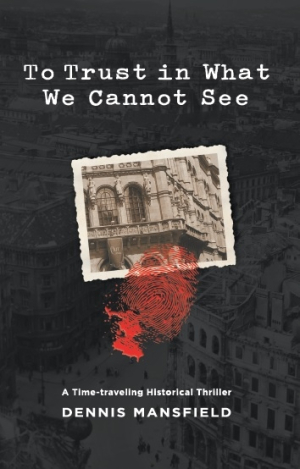To Trust in What We Cannot See
To Trust in What We Cannot See is an absorbing, science-fueled time travel novel that asks what events we might change if we had the means.
In Dennis Manfield’s novel To Trust in What We Cannot See, an author and a scientist attempt to change world events through time travel, finding that some of their activities lead to unintended consequences.
An unassuming author enters his favorite cafe, where a man introduces him to interdimensional travel. They can move through the past, present, and future. Known to each other as Author and Doctor, the men struggle with the definitive time traveler question: if you could go back and kill Adolf Hitler and prevent the rise of Nazism, would you?
While both men agree they would, the actuality of killing young Hitler leads to a more frightening future, forcing them to rethink their direct methodology. Recruiting a team of historical figures, Author and Doctor develop a generation-spanning plot that, if successful, could prevent the deaths of millions of people.
Author and Doctor engage in witty banter that, in turn, passes information to the audience. Doctor is a physicist; his often long-winded monologues supply enough scientific theory to make his interdimensional time travel schemes credible. Author is less scholarly, and he experiences some confusion in regards to the technical material that makes it more accessible. Physics and calculus may elude him, but Author’s way with words and strength for strategy are apparent. Personal details, such as Author’s love of hot chocolate and penchant for book collecting, and Doctor’s Jewish heritage and Beatles idolization, are shared in an endearing way.
Author and Doctor, realizing they cannot pull off their plan alone, recruit others to help them. The first is a young physicist, Lou, who is fast to grasp the complex science involved. The other two figures are pulled from history; Ernst Hanfstaengl, a friend of Hitler’s known as “Putzi,” and Mark Twain, referred to by his real name, Sam Clemens. Both contribute to the book’s historicity.
Lou is underdeveloped, though. She makes a vain, borderline sexist decision that is out of character. Her budding relationship with Doctor is inconsequential to the plot. A mysterious villain, also a time traveler, emerges, resulting in a sense of danger and conflict, though he remains in the background, without becoming a full-blown enemy.
The team’s adventures through time take them to many locations, captured with details like the smell of street sewage, gas-lit lamps, and changes in language. As they attempt to adhere to their settings, confusion arises: their clothing changes on its own accord to match the style of the period, for example, but without an explanation of means.
To Trust in What We Cannot See is an absorbing, science-fueled time travel novel that asks what events we might change if we had the means.
Reviewed by
Delia Stanley
Disclosure: This article is not an endorsement, but a review. The publisher of this book provided free copies of the book and paid a small fee to have their book reviewed by a professional reviewer. Foreword Reviews and Clarion Reviews make no guarantee that the publisher will receive a positive review. Foreword Magazine, Inc. is disclosing this in accordance with the Federal Trade Commission’s 16 CFR, Part 255.

